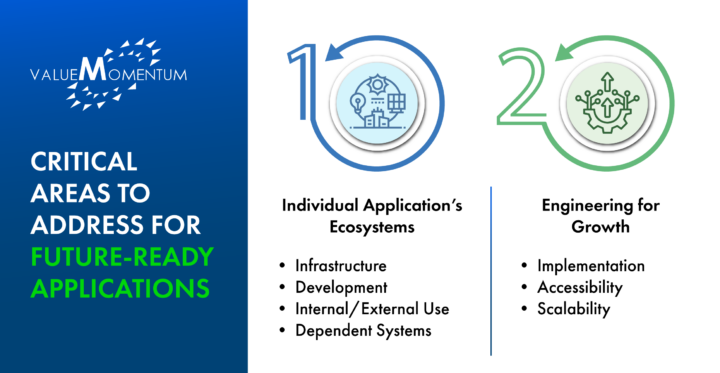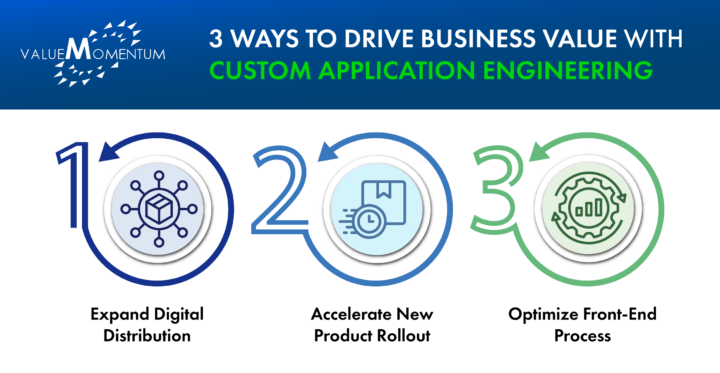Cloud has become the new default platform for insurance applications, but reaping the rewards of cloud migration requires more than simply moving applications from your on-premises data center to the cloud. Fully realizing the benefits of cloud deployment requires rethinking accessibility, integration, governance, and operations across the application life cycle. It also means rebuilding functional capabilities using cloud services and optimized engineering methods, also known as application engineering.
With thoughtful application engineering, insurers can drive value across business goals by accelerating the development of new products and services, upgrading underwriting and distribution capabilities, and streamlining back-office processes.
Application Engineering: The Path to Future-Ready Applications
Successful application engineering projects are ones that set insurers up for the future by ensuring that data and products are accessible across the organization, user experiences are both modern and consistent across distribution channels, and automated capabilities are engineered directly into the application architecture.
To develop future-ready applications, it’s important for insurers to address two critical areas:
The individual application’s ecosystem and considerations. This includes the infrastructure of the application, how the application will be developed by developers, how internal business users will use the application, the external users, and the dependent systems. Taking into account how all users will interact with the application and how the application will interact with the rest of an insurer’s IT environment will safeguard the application’s effectiveness well into the future.
How the application is engineered for growth. When engineering applications for growth, insurers need to answer the following questions:
- How will I implement the application?
- How will I make it accessible to all necessary systems and users?
- How will I scale the application?
Answering these questions and dealing with the factors involved in each can help insurers build an application architecture that is primed for growth.

Three Use Cases for Application Engineering
What does it mean to engineer an application architecture for growth? There are four main qualities required: security, configurability, scalability, and being connected to the rest of the organization. Security is, of course, paramount for insurers across all of their applications and systems. Configurability is important as configurable applications reduce the time it takes to make changes or add new applications to keep up with evolving business needs.
In addition, keeping processes agile and automated, with scalability engineered directly into the architecture, allows insurers to add new products quickly, handle major increases in traffic, and expand into new geographies rapidly. Connectivity ensures that products and data are accessible, not siloed away.
Here are three examples of how insurers have paved the way for future success using application engineering:

1. Expanding digital distribution and improving engagement
A specialty insurer was looking to enable the rapid rollout of new products; improve its customer and agent experience; and streamline the many applications it had for quoting, payments, and engagement portals. With more than 14 engagement applications, integrations with strategic partners, and various on-premises core systems, the insurer’s complex back end involved more than 45 end points.
With ValueMomentum’s help, the insurer’s architecture was streamlined through the creation of a business-aligned API layer, with a domain-driven design powered by the domain API reference solution to enable partner-specific customization. In addition, the project team used ValueMomentum’s pre-built continuous integration and continuous deployment (CI/CD) scripts to enable faster deployment and infrastructure automation. On top of simplifying the back end of the insurer’s engagement channels, the carrier is also better able to onboard partners as well as bring products and features to market rapidly.
2. Accelerating new product rollout
A Midwestern property and casualty carrier that was looking to expand its specialty lines business knew it needed to evolve the architecture supporting its applications to better support its specialty growth goals. The custom-built software the insurer had created when it first entered the specialty market was no longer keeping pace with its product rollout and forms administration needs.
With the guidance of ValueMomentum’s technical experts, the carrier engineered a modern, cloud-native architecture with a .NET microservices layer as well as a loosely coupled front end and an API integration layer using ValueMomentum’s API connectivity playbook, technical guidance, and reference automation scripts and domain models. The submission hub, which is in the final stages of implementation, has a flexible integration with the insurer’s Guidewire-based core systems, can support more than 60,000 forms, and has accelerated the rollout of new specialty products.
3. Optimizing front-end processes
A reinsurer that had five pricing analysis methodologies for more than 70 products and eight specialty business units was looking for a way to simplify its process and lead to more rapid pricing decisions and business growth. The business team wanted to have control over the pricing logic while moving away from complicated, Excel-based rating processes and manual uploading. The reinsurer was also experiencing maintenance and consistency issues.
The organization partnered with ValueMomentum for application engineering and implementation to bring in agility while assuring adherence to cloud-native principles. ValueMomentum applied modern application methodologies like domain-driven design, micro-front end and cloud-native microservices architectures to meet the engagement goals and considerations. Evolving the engineering behind the application architecture led to more rapid addition of new products and updates, a better underwriter and actuarial experience, and cleaner integration with internal systems. ValueMomentum’s API templates left the reinsurer with the playbook and reference domain models needed to manage future growth.
Achieving Rapid Growth With Future-Ready Applications
With cloud investments continuing to grow and application architectures becoming more complex, custom application engineering efforts can help insurers streamline their IT environment and drive business value. Modern, scalable, and secure technology frameworks allow insurers and reinsurers to streamline their processes and reach their current and future growth goals.
Check out our webinar, Evolving Digital Distribution Strategies for Insurance, to learn how application engineering can help your organization maximize its business value.
